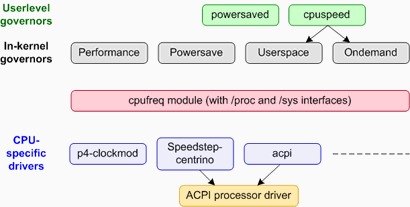

mkdir /sys mount -t sysfs sys /sys
A per-CPU directory is available in sysfs under /sys/devices/system/cpu. Note that Hyper-Threading Technology siblings will each appear separately in sysfs.
linux: # pwd /sys/devices/system/cpu linux: # ls -l total 0 drwxr-xr-x 6 root root 0 Jul 31 22:50 . drwxr-xr-x 8 root root 0 Jul 31 22:50 .. drwxr-xr-x 3 root root 0 Jul 31 22:50 cpu0 drwxr-xr-x 3 root root 0 Jul 31 22:50 cpu1 drwxr-xr-x 3 root root 0 Jul 31 22:50 cpu2 drwxr-xr-x 3 root root 0 Jul 31 22:50 cpu3
All the information exported by the cpufreq interface can be found under the cpuX/cpufreq directory.
linux: # pwd /sys/devices/system/cpu/cpu1/cpufreq linux: # ls -l total 0 drwxr-xr-x 2 root root 0 Jul 31 22:51 . drwxr-xr-x 3 root root 0 Jul 31 22:50 .. r—-r-—r-- 1 root root 4096 Jul 31 22:51 cpuinfo_max_freq r—-r-—r-- 1 root root 4096 Jul 31 22:51 cpuinfo_min_freq r—-r-—r-- 1 root root 4096 Jul 31 22:51 scaling_available_frequencies r—-r—-r-- 1 root root 4096 Jul 31 22:51 scaling_available_governors r—-r—-r-- 1 root root 4096 Jul 31 22:51 scaling_cur_freq r—-r—-r-- 1 root root 4096 Jul 31 22:51 scaling_driver rw-r—-r-- 1 root root 4096 Jul 31 22:51 scaling_governor rw-r-—r-- 1 root root 4096 Jul 31 22:51 scaling_max_freq rw-r—-r-- 1 root root 4096 Jul 31 22:51 scaling_min_freq
All the files in the above listing are readable (cat {filename}) and will contain the value for that particular variable. Some of the files are writable (echo {value} > {filename}), and they set a particular value to the variable.
Descriptions of the key entries here are as follows:
The entry scaling_driver contains the name of the low-level CPU-specific driver that is being used on this system:
linux: # cat scaling_driver acpi-cpufreq
The entry scaling_available_frequencies contains a list of all the frequencies supported on the processor (all frequency values are expressed in KHz):
linux: # cat scaling_available_frequencies 3400000 2800000
The entry scaling_cur_freq provides an interface to get the current frequency:
linux: # cat scaling_cur_freq 3400000
The entry scaling_available_governors lists all the governors that can be used in this system:
linux: # cat scaling_available_governors ondemand userspace performance
The entry scaling_governor provides a read-write interface that shows the current policy governor being used. A new value, from among the list obtained from scaling_available_governors, can be written into this file, and the system will start using this new governor on this CPU:
linux: # cat scaling_governor performance linux: # echo “userspace” > scaling_governor linux: # cat scaling_governor userspace
The entries scaling_max_freq and scaling_min_freq are the parameters to the policy governor. They are read-write and control the behavior of the governor:
linux: # cat scaling_max_freq 3400000 linux: # cat scaling_min_freq 2800000
Every X milliseconds
Get the current CPU utilization
If the utilization is more than UP_THRESHOLD %
Increase the P-state to the maximum frequency
Every Y milliseconds
Get the current CPU utilization
If the utilization is less than DOWN_THRESHOLD %
Decrease P-state to next available lower frequency
The ondemand governor, when supported by the kernel, will be listed in the /sys interface under scaling_available_governors. Users can start using the ondemand governor as the P-state policy governor by writing onto scaling_governor:
linux: # cat scaling_available_governors ondemand userspace performance linux: # echo “ondemand” > scaling_governor linux: # cat scaling_governor ondemand
Note that this sequence must be repeated on all the CPUs present in the system. Once this is done, the ondemand governor will take care of adjusting the CPU frequency automatically, based on the current CPU usage. CPU usage is based on the idle_ticks statistics.
Because a single policy governor cannot satisfy all of the needs of applications in various usage scenarios, the ondemand governor supports a number of tuning parameters. The following explanation reveals what each tuning parameter means, as well as the default value of each:
linux: # echo “ondemand” > scaling_governor linux: # ls -l total 0 drwxr-xr-x 3 root root 0 Aug 5 04:23 . drwxr-xr-x 3 root root 0 Jul 31 22:50 .. r—-r—-r-- 1 root root 4096 Jul 31 22:51 cpuinfo_max_freq r—-r—-r-- 1 root root 4096 Jul 31 22:51 cpuinfo_min_freq drwxr-xr-x 2 root root 0 Aug 5 04:23 ondemand r—-r—-r-- 1 root root 4096 Jul 31 22:51 scaling_available_frequencies r—-r-—r-- 1 root root 4096 Jul 31 22:51 scaling_available_governors r—-r-—r-- 1 root root 4096 Jul 31 22:51 scaling_cur_freq r—-r-—r-- 1 root root 4096 Jul 31 22:51 scaling_driver rw-r—-r-- 1 root root 0 Aug 5 04:23 scaling_governor rw-r—-r-- 1 root root 4096 Jul 31 22:51 scaling_max_freq rw-r—-r-- 1 root root 4096 Jul 31 22:51 scaling_min_freq
Note the new ondemand sub-directory.
linux: # cd ondemand/ linux: # ls -l total 0 drwxr-xr-x 2 root root 0 Aug 5 04:23 . drwxr-xr-x 3 root root 0 Aug 5 04:23 .. rw-r—-r-- 1 root root 4096 Aug 5 04:23 down_threshold rw-r—-r-- 1 root root 4096 Aug 5 04:23 sampling_down_factor rw-r—-r-- 1 root root 4096 Aug 5 04:23 sampling_rate r-—r—-r-- 1 root root 4096 Aug 5 04:23 sampling_rate_max r—-r—-r-- 1 root root 4096 Aug 5 04:23 sampling_rate_min rw-r—-r-- 1 root root 4096 Aug 5 04:23 up_threshold
This directory contains all the ondemand algorithm-tuning variables.
linux: # cat sampling_rate_max 55000000 linux: # cat sampling_rate_min 55000
These times are measured in microseconds, denoting the minimum and maximum sampling rate. These values are read-only, and predetermined by the kernel as a factor of P-state transition latency.
linux: # cat sampling_rate 110000
This read-write field denotes a value in microseconds. The ondemand governor checks CPU utilization and tries to increase the CPU frequency at this rate.
linux: # cat sampling_down_factor 10
This is a read-write integer value that is multiplied with sampling_rate and used to the rate at which the ondemand governor checks CPU utilization and tries to lower the CPU frequency.
linux: # cat up_threshold 80 linux: # cat down_threshold 20
These are read-write fields that stand for CPU-utilization thresholds. Whenever the current utilization is more than up_threshold, the ondemand governor will increase the frequency to the maximum. Whenever the CPU utilization is less than the down_threshold, the ondemand governor tries to reduce the frequency to the next available lower P-state.
The Userspace Govenor
The Userspace governor allows any user-space utility to change the CPU frequency, by writing some value a file under /sys.
linux: # echo “userspace” > scaling_governor linux: # cat scaling_governor userspace linux: # ls -l total 0 drwxr-xr-x 2 root root 0 Jul 31 22:51 . drwxr-xr-x 3 root root 0 Jul 31 22:50 .. r--r--r-- 1 root root 4096 Jul 31 22:51 cpuinfo_max_freq r--r--r-- 1 root root 4096 Jul 31 22:51 cpuinfo_min_freq r--r--r-- 1 root root 4096 Jul 31 22:51 scaling_available_frequencies r--r--r-- 1 root root 4096 Jul 31 22:51 scaling_available_governors r--r—r-- 1 root root 4096 Jul 31 22:51 scaling_cur_freq r--r—r-- 1 root root 4096 Jul 31 22:51 scaling_driver rw-r--r-- 1 root root 0 Jul 31 22:51 scaling_governor rw-r--r-- 1 root root 4096 Jul 31 22:51 scaling_max_freq rw-r--r-- 1 root root 4096 Jul 31 22:51 scaling_min_freq rw-r--r-- 1 root root 4096 Aug 4 18:46 scaling_setspeed
Note a new file here, scaling_setspeed:
linux: # cat scaling_setspeed 3400000 linux: # echo 2800000 > scaling_setspeed linux: # cat scaling_setspeed 2800000
The file scaling_setspeed is read-write. When read, it denotes the current CPU frequency. The user can write a value to this field (using the list in scaling_available_frequencies), and the CPU will change the frequency to the one specified by the user. There are different CPU frequency governors, implemented as user-space daemons. They control the frequency by reading and writing values to and from scaling_setspeed. Two such user-level daemons that are widely used are powersaved and cpuspeed.
The relative advantages of in-kernel governors and user-space governors are listed here. This will help users (or administrators) in determining what kind of governor one should use under various system-usage scenarios. The advantages of in-kernel governors include the following:
The advantages of user-space governors include the following:
General config menu ->
Power management options ->
ACPI Support
<*> ACPI Support
[*] Processor
General config menu ->
Power management options ->
CPU Frequency scaling
[*] CPU Frequency scaling
<*> /proc/cpufreq interface (deprecated)
[*] /proc/sys/cpu/ interface (2.4. / OLD)
Default CPUFreq governor (userspace) --->
<*> 'performance' governor
<*> 'powersave' governor
--- 'userspace' governor for userspace frequency scaling
<*> 'ondemand' cpufreq policy governor
<*> CPU frequency table helpers
--- CPUFreq processor drivers
<*> ACPI Processor P-States driver
[ ] /proc/acpi/processor/../performance interface
(deprecated)
<*> Intel Enhanced SpeedStep
[*] Use ACPI tables to decode valid frequency/voltage pairs
(EXPERIMENTAL)
< > Intel Speedstep on ICH-M chipsets (ioport interface)
< > Intel SpeedStep on 440BX/ZX/MX chipsets (SMI interface)
< > Intel Pentium 4 clock modulation
: : :
: : :
: : :
|
| UP EST (i386) | 2.6.8 and above |
| SMP EST(i386) | 2.6.9 and above |
| UP EST(EM64T) | 2.6.9 and above |
| SMP EST EM64T | 2.6.9 and above |
| Ondemand governor | 2.6.9 and above |
 Venkatesh
Pallipadi is a Senior Software Engineer on Intel's Linux OS Technology
Team in Santa Clara, California. He works on enabling various new
processor features in the Linux kernel, across i386, Intel® EM64T and
Itanium® Processor Family architectures. Prior to joining Intel,
Venkatesh received his ME (Computer Science and Automation) at the
Indian Institute of Science in Bangalore, India. He can be reached at venkatesh.pallipadi@intel.com.
Venkatesh
Pallipadi is a Senior Software Engineer on Intel's Linux OS Technology
Team in Santa Clara, California. He works on enabling various new
processor features in the Linux kernel, across i386, Intel® EM64T and
Itanium® Processor Family architectures. Prior to joining Intel,
Venkatesh received his ME (Computer Science and Automation) at the
Indian Institute of Science in Bangalore, India. He can be reached at venkatesh.pallipadi@intel.com.#!/bin/bash
get_governors_on_cpu() {
if [ “$#” -ne 1 ]
then
echo $”Usage: get_governors_on_cpu {cpu}”
return 1
else
cpu=$1
fi
dir=/sys/devices/system/cpu/cpu${cpu}/cpufreq
if [ -d $dir ]
then
cd $dir
cat scaling_available_governors
else
echo “CPU” ${cpu} “ available policy get FAILED”
return 1
fi
return 0
}
get_governors() {
if [ “$#” -ne 0 ]
then
echo $”Usage: get_governors”
return 0
fi
p1=‘pwd‘
if [ ! -d /sys ]
then
mkdir /sys
fi
if [ ! -d /sys/devices ]
then
mount -tsysfs sysfs /sys
fi
get_governors_on_cpu 0
RETVAL=$?
if [ $RETVAL -ne 0 ]
then
cd $p1
return $RETVAL;
fi
cd $p1
return 0
}
get_governors $1
exit $?
|
|
|